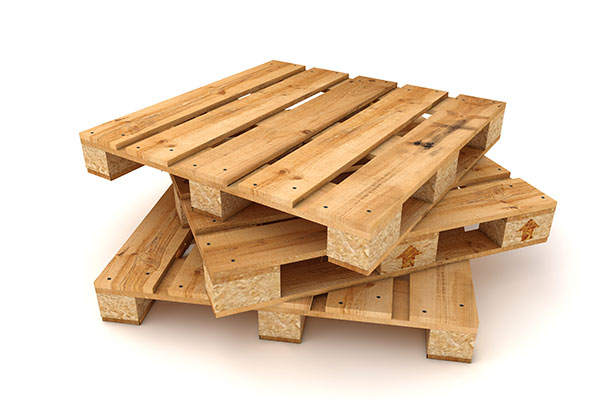Annual Pallet Report 2021: Short Supply Meets High Demand
Demand for pallets is running high, as reflected by pallet use trends from our 2021 survey. However, there was a sharp rise in respondents having issues with availability and cost with used wood pallets, and a modest rise in readers using semi- or fully-automated pallet wrapping equipment.
Pallets are perhaps the most fundamental asset needed to keep goods moving in bulk in supply chains, right up there with lift trucks. Individually, a pallet is a humble asset and their importance is easy to overlook, but collectively, when issues arise with their availability or escalating price, suddenly pallets become a hot-button issue.
This past year has been one of those time periods when pallets have been challenging or more expensive to acquire, as reflected in findings from our 2021 “Pallet Report.” Modern and Peerless Research Group conduct the survey annually, and this year, the study was in the field during June, garnering 176 responses from readers who use pallets.
The survey came at a highly challenging time for the pallet industry. Prices for lumber reached record highs this spring as other industries that use lumber, such as construction and furniture, saw an upshot in activity and demand.
Prices for lumber have come down a bit recently, but when lumber prices are high, the price the pallet industry needs to pay for fiber and lumber also goes up, leading to fewer pallets being built and constrained supply. Meanwhile, with the economy picking up as the pandemic began to subside, the demand for pallets to move goods has remained strong.
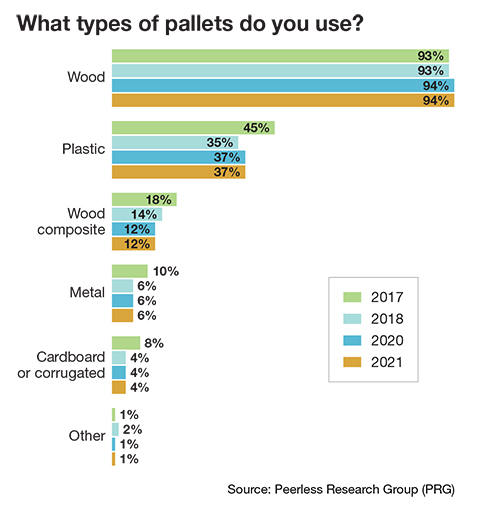
These dynamics, coupled with labor scarcity and other long-standing issues within the makeup of the pallet industry, set the stage for some challenging times, as recently noted by Doug Gaier, director of procurement for Millwood, a leading supplier of packaging materials as well as of new, used and reconditioned pallets.
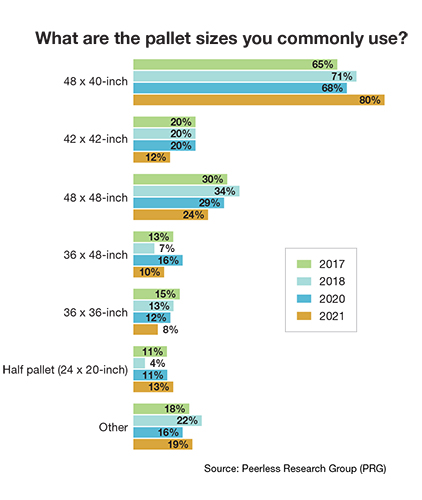
“The market for pallets is really explained through the simplest of economic principles—supply and demand,” explains Gaier, speaking during a recent “Talking Supply Chain” podcast hosted by Modern’s executive editor Bob Trebilcock. “The supply is not what it needs to be…and the demand for pallets has really just skyrocketed as the country has emerged from the pandemic.”
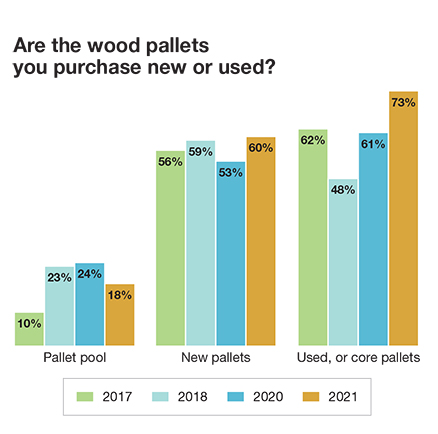
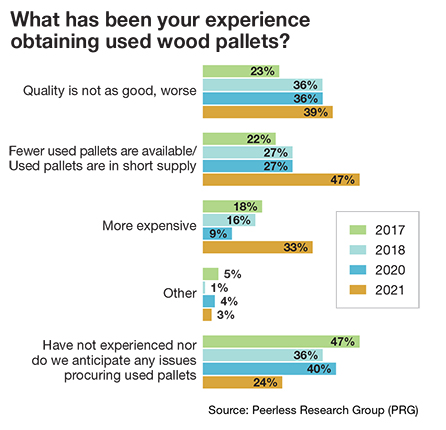
These supply-constrained times are reflected in our survey, which asks about pallet use trends, not only for wooden pallets, but other types such as plastic and metal pallets. The survey asks about changing use levels, sizes most commonly used, use of new versus used pallets, and use of pallet rental or pooling services.
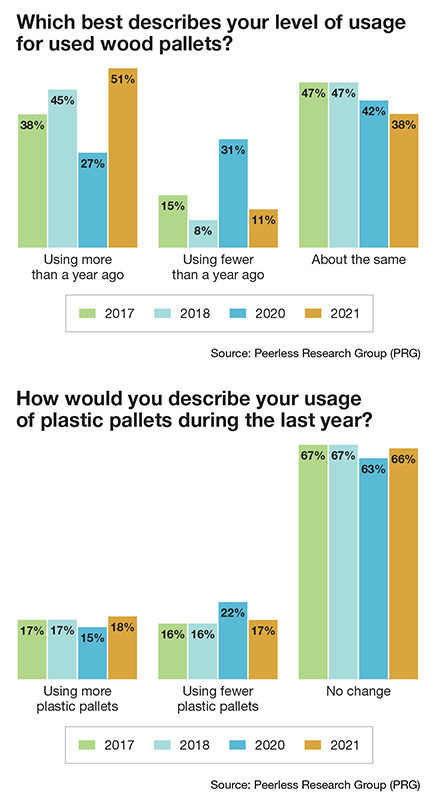 Overall, some things have remained the same—such as wood pallets easily remaining the most common type—but others, such as problems with availability or cost, were on the rise this year, at least for some pallet types.
Overall, some things have remained the same—such as wood pallets easily remaining the most common type—but others, such as problems with availability or cost, were on the rise this year, at least for some pallet types.
Most respondents (51%) work in manufacturing companies across several different verticals, with 18% in whole trade, durables; 10% in retail; 7% in wholesale, non-durables; and 14% in other sectors. In terms of company revenue, the biggest portion work for companies with annual revenues of less than $10 million (24%), another 22% are with companies in the $10 million to $49.9 million range, and 17% in the $50 million to $99.9 million range.
Wood still rules
Wood overwhelmingly remains the top type of pallet material. This year, 94% of respondents said they are using wood pallets in their operations, same as the previous year. Another 37% say they use plastic pallets (same as in 2020) and 12% use wood composite pallets, also even with the previous survey. Another 6% of companies use metal pallets, 4% use cardboard or corrugated, and 1% use some other material.
Most (72%) companies are using pallets to ship or receive corrugated boxes, with plastic totes/reusable plastic containers (RPCs) making up 18% of package types shipped or received (up from 6% in 2020); pails at 17% (up from 9%); bags at 15% (down from 21%); drums at 14% (up from 10%); and flexible intermediate bulk containers, or FIBCs, at 6% this year.
As far as pallet size, a strong majority (80%) of respondents use the standard 48 x 40-inch version, up significantly from 68% in 2020. Twenty-four percent use a slightly larger 48 x 48-inch square pallet, while 12% use 42 x 42-inch pallets. Compared to the previous year, smaller percentage uses were reported for 36 x 48-inch pallets (10% this year) and the 36 x 36-inch (8% this year), though a slightly larger percentage (13%) reported using the 24 x 20-inch “half pallet” size this year, up 2%.
The survey annually asks if the wood pallets purchased are new or used. This year, 60% said they purchased new wood pallets, which is up from 53% last year. Use of used wooden pallets also rose. Last year, 61% reported using used or “core” pallets (the industry term for used wooden pallets that can be refurbished), and this year, that level rose to 73%. Use of a pallet pool dropped to 18% this year from 24% in 2020.
However, significant issues were reported with the ease and expense of acquiring used wooden pallets in 2021. While the reported quality level held pretty steady, this year, 47% said fewer used wood pallets are available, a 20% increase from last year’s 27% who reported availability issues. Additionally, 33% of respondents said obtaining used wood pallets was more expensive this year, compared with 9% who said so last year.
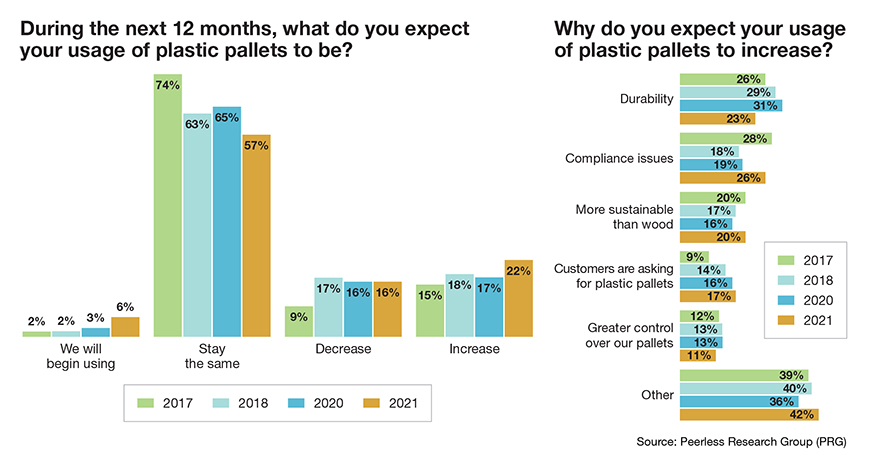
The percentage of respondents reporting they have not experienced, nor anticipate, issues procuring used wood pallets came in at 24% this year, down from 40% in 2020. In essence, a significantly smaller chunk of respondents this year said they had no real issues procuring used wood pallets, compared to the previous year.
Yet even with some challenges, 51% report using more used wood pallets this year compared to the previous year, up from 27% for the same response last year. Additionally, 11% said they are using fewer used wood pallets than the year before (vs. 31% in 2020). It’s likely these findings could tie into general economic recovery and the over-riding need to procure more pallets, even with challenges in doing so.
Plastic trends up
This year, 18% are using more plastic pallets, up slightly from 15% last year. More than half of the respondents (66%) say their plastic pallet use level hasn’t changed in the last year, up 3% from last year.
Over the next year, 22% expect their use of plastic pallets to increase while 16% expect a decrease and 57% say their usage will stay the same. Last year, 17% forecast an increase, so slightly more respondents this year anticipate more use of plastic pallets in the coming year.
Of those companies that do anticipate more use of plastic pallets; 23% say it’s due to durability; 26% say it’s because of compliance; 20% feel plastic is more sustainable than wood; and 17% say it’s because their customers are asking for them. Another 11% also feel they have greater control over plastic pallets versus other materials.
Rental model rising
This year, 12% of respondents are using or plan to use a pallet rental company, up from 9% in 2020. Fourteen percent say they use (or plan to use) another type of pallet retrieval or recovery system, down from 16% in 2018. Asked whether their company rents, plans to rent, or uses a pallet retrieval/recovery provider, 74% said “no”—down 1% from 2020.
We also ask about the likelihood of participating in a pallet retrieval, recovery system or a third-party pallet rental system over the next 12 months. Currently, 9% say participation is “highly likely” over the next year, up 3% from last year. Sixteen percent say it is “likely” they will use one of these systems, up from 13% in 2020. This year, 21% say it’s “not very likely” they’ll be using such a system, down from 30% the previous year. Additionally, 39% say it’s “not at all likely” for use of this type of system (vs. 33% in 2020), and 15% say they are unfamiliar with these type systems, compared to 19% who were unfamiliar last year.
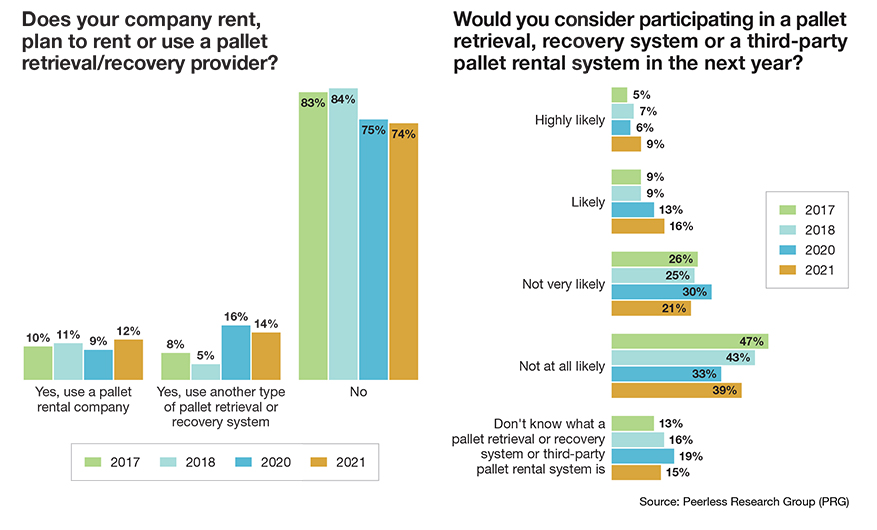
Overall, these results indicate some rising interest in pallet rental/pooling. It’s possible that the model is gaining momentum as an attractive alternative. However, it may also be the case that in a time of high demand for goods and constrained pallet supply, companies are trying out every possible option to obtain the pallets they need, or at least don’t rule out the option of trying such services.
International trends
For 2021, 45% of companies said the nature of pallet shipments is domestic, down from 66% in 2020. Only 2% characterize the nature of their pallet shipments as international, same as in 2020. Another 53% this year say they ship pallets domestically and internationally, which is up from 33%. These findings are likely tied to pandemic impacts, and the gradual opening up of international trade and travel during 2021.
In terms of countries or regions that pallets are shipped to, the leading country/regions are Canada and Mexico, South America and the Caribbean, with only minor percentage changes versus our 2020 findings. However, whereas last year the number of organizations shipping pallets to China, Japan, Southeast Asia, North Asia and Australasia plummeted to 33%, this year, pallet shipments to Asia Pac bounced back to 55%, more in line with the pre-pandemic levels our survey has found for this region the last few years.
For European shipments, 54% ship to Western Europe (up from 48% in 2020) and 41% ship to Eastern Europe (up sharply from 24% in 2020). In 2021, 34% of companies are shipping pallets to the Middle East and North Africa—up from 10% last year.
Over the next two years, 57% of companies expect an increase in the number of pallets that they’re shipping internationally (versus 36% last year). Conversely, 39% say their international shipments will hold steady, down 20% from 2020 and 4% expect a decrease. Quite clearly, 2021 has brought about a more robust flow of international shipments versus 2020, again likely tied to pandemic conditions improving in the first half of 2021.
When shipping internationally, many organizations take special precautions with their palleted goods. Almost half (49%) say they have their pallets treated when shipping internationally, and 25% use wood pallets that they own. Fourteen percent of respondents use plastic, corrugated, pressed wood or metal—rather than wood—when shipping internationally, up from 5% that said they used these alternatives last year.
Over the past two years, 11% of companies say the number of pallets shipped internationally has decreased (versus 23% in 2020). Fifty-five percent say their number of pallets shipped internationally remained the same, while 34% increased that volume over the past two years. Of course, the last two years have brought highly unusual pandemic conditions, so it may take a year or two more of the survey (and complete waning of the pandemic) for international trends to stabilize.
Load stabilization trends
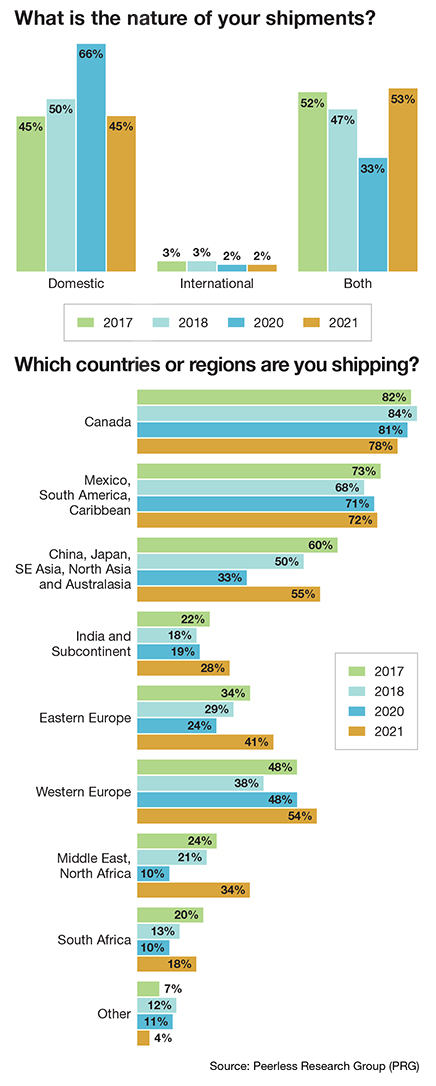 Asked what percentage of unit loads shipped/received by their company are stabilized with particular methods, 64% say their loads are stabilized with stretch film and 46% say shrink film, both at slightly higher percentages than in 2020.
Asked what percentage of unit loads shipped/received by their company are stabilized with particular methods, 64% say their loads are stabilized with stretch film and 46% say shrink film, both at slightly higher percentages than in 2020.
Thirty four percent of respondents say they use strapping/banding to stabilize loads (down from 40% in 2020), while 13% use tie sheets, 9% use Lock’n Pop Adhesive, 7% use a stretch hood, and 12% use a shrink hood. Additionally, 17% use an interlocking system, up from 4% in 2020.
When it comes to manual and automated stretch wrapping, 46% of organizations manage all of their wrapping manually (vs. 41% last year), while 26% have some automated stretch wrappers. This year, 25% say all of their operation uses semi- or fully-automated stretch wrappers, which is up 5% from last year. Some trend toward automation can be seen, though a significant number of respondents are still doing things manually.
Another part of our survey asked readers if they are using, or have used, a third-party service to better understand the pallet and transport packaging combination (i.e., stretch wrap, shrink wrap, banding) that best suits their operation. This year, 23% said yes to this question, up from 10% in 2020. Those saying they are either somewhat interested, very, or extremely interested in pallet and transport packaging advice also grew, but by 1%.
Tapping into data
In assessing offerings from pallet providers, 24% say their providers offer vendor managed pallet inventory/just-in-time (VMI/JIT) delivery, up from 21% in 2020. And, when asked if available, would they use a VMI/JIT service, 39% expressed interest, down 3% from 2020.
In addition, 24% say providers offer on-site recycling and reclamation management (down from 32% in 2020), and 10% say they offer data or information related to their supply chain network (up by 1%). Twenty-eight percent say their providers offer backhauls, compared to 32% in 2020. On-site crate assembly and delivery to a manufacturing line is an offering that 11% report this year, up from 7% in 2020.
 Interestingly, if available from a provider, 24% are now interested in data or information related to their network, up sharply from the 9% who expressed interest in such services in 2020. There was also a slight increase in interest in on-site recycling and reclamation management.
Interestingly, if available from a provider, 24% are now interested in data or information related to their network, up sharply from the 9% who expressed interest in such services in 2020. There was also a slight increase in interest in on-site recycling and reclamation management.
Load stability issues were experienced by 24% of respondents this year, down from 29% last year. Conversely, 76% this year said they do not experience load stability issues, which is down by 5% compared to 2020.
Of those that did report load stability issues this year, 4% experience unit load stability issues daily, 42% experience them weekly, 35% experience them monthly, and 8% experience them quarterly. Compared to last year, the major change was a sharp decrease in those reporting daily issues with load stability.
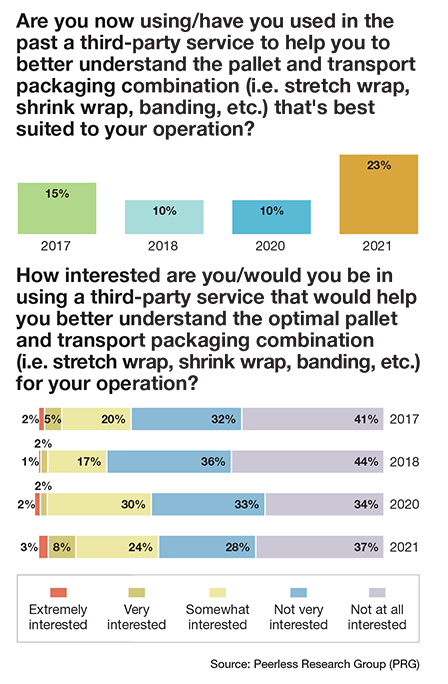 When asked about the level of standardization to stabilize unit loads, almost half (48%) say they use some standardization (same as last year), while 30% say they are highly standardized (down 3%), 4% reported a lack of standardization (vs. 6% last year), and 18% say they have no standardization at all (vs. 13%) in 2020.
When asked about the level of standardization to stabilize unit loads, almost half (48%) say they use some standardization (same as last year), while 30% say they are highly standardized (down 3%), 4% reported a lack of standardization (vs. 6% last year), and 18% say they have no standardization at all (vs. 13%) in 2020.
In assessing the use of Internet of Things (IoT) in relation to pallets, 4% of respondents say they have a current business need that could be satisfied using IoT-enabled pallets in their supply chains, same as last year.
In this year of rising lumber prices and rising costs for wooden pallets, it may be that the main concern, rather than use of technology like IoT enabled pallets, has simply been finding enough pallets to ship goods in a resurgent economy. Use of multiple types of pallets was on the upswing even though respondents who leverage used wood pallets reported more issues around expense and availability.
Ultimately, in a time of tight pallet supply and high demand for moving goods, respondents seem to be tapping into multiple alternatives to secure enough pallets. This year’s survey also shows resurgent international shipments, fewer issues around load stability, and more interest in information or data from providers to help guide pallet decisions.
Overall, encouraging signs can be seen in this year’s survey. However, it remains to be seen if the pandemic and its variants will completely subside, and when, and if, prices for lumber will stabilize long term to make it attractive for pallet builders to increase the supply of wooden pallets that remain so crucial to moving goods.
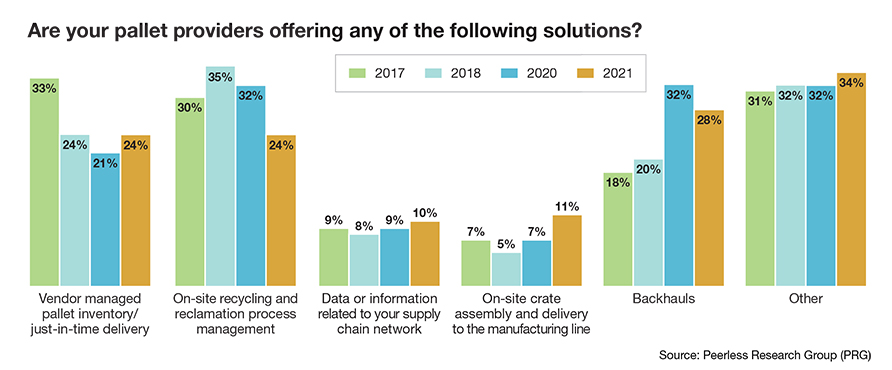

Article Topics
Shipping Pallets News & Resources
Two voices of reason on pallet materials Pallet recycler and services company PLA appoints Steve Clark as CEO Cobot as key ingredient for palletizing efficiency CHEP appoints Xavier Garijo to newly created CEO Americas position Pallet company Kamps announces executive team changes PLA names Jenny Bedard as new CFO Moving pallets at Aurobindo More Shipping PalletsLatest in Materials Handling
Beckhoff USA opens new office in Austin, Texas Manhattan Associates selects TeamViewer as partner for warehouse vision picking ASME Foundation wins grant for technical workforce development The (Not So) Secret Weapons: How Key Cabinets and Asset Management Lockers Are Changing Supply Chain Operations MODEX C-Suite Interview with Harold Vanasse: The perfect blend of automation and sustainability Consultant and industry leader John M. Hill passes on at age 86 Registration open for Pack Expo International 2024 More Materials HandlingAbout the Author
Subscribe to Materials Handling Magazine

Find out what the world's most innovative companies are doing to improve productivity in their plants and distribution centers.
Start your FREE subscription today.
April 2024 Modern Materials Handling

Latest Resources


